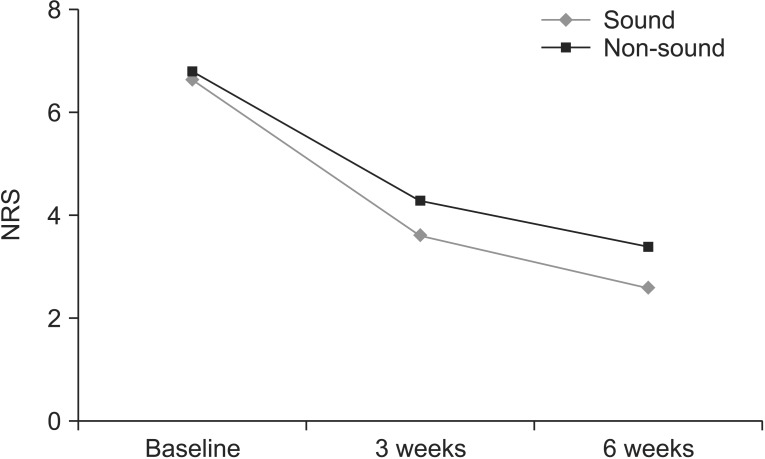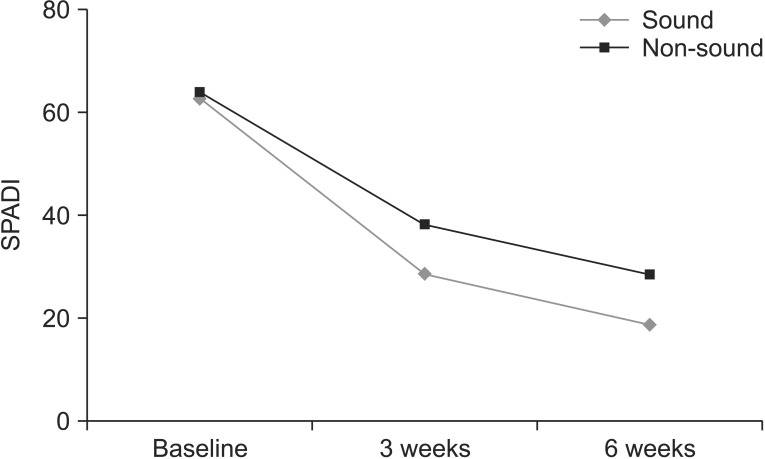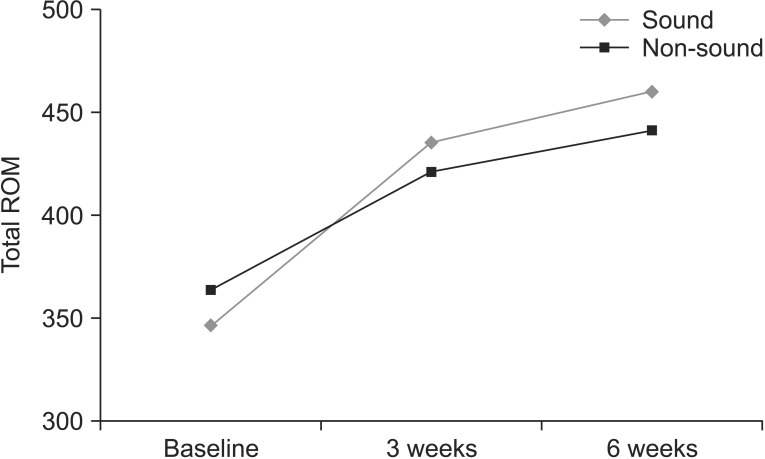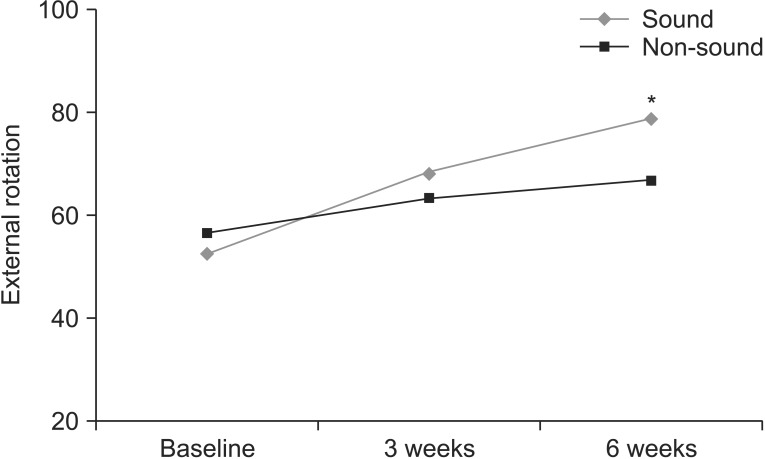Ann Rehabil Med.
2015 Oct;39(5):745-751. 10.5535/arm.2015.39.5.745.
Shoulder Manipulation After Distention Arthrography: Does Audible Cracking Affect Improvement in Adhesive Capsulitis? A Preliminary Study
- Affiliations
-
- 1Department of Physical Medicine and Rehabilitation, Korea University Guro Hospital, Seoul, Korea. rehab46@korea.ac.kr
- KMID: 2148205
- DOI: http://doi.org/10.5535/arm.2015.39.5.745
Abstract
OBJECTIVE
To investigate whether an audible cracking sound during shoulder manipulation following distention arthrography is clinically significant in patients with adhesive capsulitis of the shoulder.
METHODS
A total of 48 patients (31 women, 17 men) with primary adhesive capsulitis of the shoulder completed the study. All participants underwent C-arm-guided arthrographic distention of the glenohumeral joint with injections of a corticosteroid and normal saline. After distention, we performed flexion and abduction manipulation of the shoulder. The patients were grouped into sound and non-sound groups based on the presence or absence, respectively, of an audible cracking sound during manipulation. We assessed shoulder pain and disability based on a Numeric Rating Scale (NRS), the Shoulder Pain and Disability Index (SPADI), and passive range of motion (ROM) measurements (flexion, abduction, internal and external rotation) before the procedure and again at 3 weeks and at 6 weeks after the intervention.
RESULTS
The patients were divided into two groups: 21 were included in the sound group and 27 in the non-sound group. In both groups, the results of the NRS, SPADI, and ROM assessments showed statistically significant improvements at both 3 and 6 weeks after the procedure. However, there were no significant differences between the two groups except with respect to external rotation at 6 weeks, at which time the sound group showed a significant improvement in external rotation when compared with the non-sound group (p<0.05).
CONCLUSION
These findings showed that manipulation following distention arthrography was effective in decreasing pain and increasing shoulder range of motion. In addition, the presence of an audible cracking sound during manipulation, especially on external rotation, was associated with better shoulder range of motion.
Keyword
MeSH Terms
Figure
Cited by 1 articles
-
Comparison of Therapeutic Effectiveness Between Shoulder Distention Arthrography With Translation Mobilization and Distention Arthrography Alone in Patients With Frozen Shoulder
Gi Young Park, Dong Rak Kwon, Dae Gil Kwon, Jae Hwal Rim
Ann Rehabil Med. 2018;42(1):76-84. doi: 10.5535/arm.2018.42.1.76.
Reference
-
1. Carette S. Adhesive capsulitis: research advances frozen in time? J Rheumatol. 2000; 27:1329–1331. PMID: 10852248.2. Rizk TE, Gavant ML, Pinals RS. Treatment of adhesive capsulitis (frozen shoulder) with arthrographic capsular distension and rupture. Arch Phys Med Rehabil. 1994; 75:803–807. PMID: 8024429.
Article3. Jacobs LG, Smith MG, Khan SA, Smith K, Joshi M. Manipulation or intra-articular steroids in the management of adhesive capsulitis of the shoulder? A prospective randomized trial. J Shoulder Elbow Surg. 2009; 18:348–353. PMID: 19393928.
Article4. van Royen BJ, Pavlov PW. Treatment of frozen shoulder by distension and manipulation under local anaesthesia. Int Orthop. 1996; 20:207–210. PMID: 8872541.
Article5. Amoretti N, Grimaud A, Brocq O, Roux C, Dausse F, Fournol M, et al. Shoulder distension arthrography in adhesive capsulitis. Clin Imaging. 2006; 30:254–256. PMID: 16814141.
Article6. Loew M, Heichel TO, Lehner B. Intraarticular lesions in primary frozen shoulder after manipulation under general anesthesia. J Shoulder Elbow Surg. 2005; 14:16–21. PMID: 15723009.
Article7. Lundberg BJ. The frozen shoulder: clinical and radiographical observations. Acta Orthop Scand Suppl. 1969; 119:1–59. PMID: 4952729.8. Kivimaki J, Pohjolainen T, Malmivaara A, Kannisto M, Guillaume J, Seitsalo S, et al. Manipulation under anesthesia with home exercises versus home exercises alone in the treatment of frozen shoulder: a randomized, controlled trial with 125 patients. J Shoulder Elbow Surg. 2007; 16:722–726. PMID: 17931902.9. Khan JA, Devkota P, Acharya BM, Pradhan NM, Shreshtha SK, Singh M, et al. Manipulation under local anesthesia in idiopathic frozen shoulder: a new effective and simple technique. Nepal Med Coll J. 2009; 11:247–253. PMID: 20635603.10. Buchbinder R, Youd JM, Green S, Stein A, Forbes A, Harris A, et al. Efficacy and cost-effectiveness of physiotherapy following glenohumeral joint distension for adhesive capsulitis: a randomized trial. Arthritis Rheum. 2007; 57:1027–1037. PMID: 17665470.
Article11. Roach KE, Budiman-Mak E, Songsiridej N, Lertratanakul Y. Development of a shoulder pain and disability index. Arthritis Care Res. 1991; 4:143–149. PMID: 11188601.
Article12. Tveita EK, Tariq R, Sesseng S, Juel NG, Bautz-Holter E. Hydrodilatation, corticosteroids and adhesive capsulitis: a randomized controlled trial. BMC Musculoskelet Disord. 2008; 9:53. PMID: 18423042.
Article13. Goldberg BA, Scarlat MM, Harryman DT 2nd. Management of the stiff shoulder. J Orthop Sci. 1999; 4:462–471. PMID: 10664431.14. Mao CY, Jaw WC, Cheng HC. Frozen shoulder: correlation between the response to physical therapy and follow-up shoulder arthrography. Arch Phys Med Rehabil. 1997; 78:857–859. PMID: 9344306.
Article
- Full Text Links
- Actions
-
Cited
- CITED
-
- Close
- Share
- Similar articles
-
- Observation of Treatment Outcome with Radiography in Adhesive Capsulitis of Shoulder
- Adhesive Capsulitis of the Shoulder
- Ultrasonography and arthrography in rotator cuff lesions: algorithmic approach
- The Effects of Stellate Ganglion Block in Adhesive Capsulitis of the Shoulder
- Arthroscopic Management and Manipulation of Chronic Idiopathic Adhesive Capsulitis of the Shoulder





